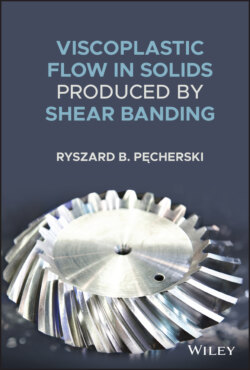Читать книгу Viscoplastic Flow in Solids Produced by Shear Banding - Ryszard B. Pecherski - Страница 9
1.3 State of the Art 1.3.1 Motivation Resulting from Industrial Applications
ОглавлениеKorbel and Szyndler (2010) presented an overview of the Polish engineering inventions' contribution to metal‐forming technologies. Three industrial sectors can play an important role: electrical power plants, transportation, and natural environment protection. First of all, one should focus on high‐quality and energy‐saving extrusion and forging processes of the elements made of structural steel, non‐ferrous metals, and light alloys used to produce parts of machines and other equipment manufactured by all industry sectors.
There is a need and necessity to implement innovative technical and technological solutions into metal‐forming practice, making production more efficient, energy‐saving, and less expensive. So, we face three challenges with new, non‐conventional technologies, such as metal‐processing technology in the cyclically variable plastic deformation – known as the KOBO method, cf. the US and European patents description Korbel and Bochniak (1998). The technological solution of metal forming, the KOBO method, satisfies both demands: low manufacturing costs and control of the metal substructure properties in a single operation. The premises, at the background of the method, result from the thorough experimental studies of plastic deformation mechanisms in the course of strain path change conditions (Korbel and Szyndler 2010). The change in the mode of plastic flow from the crystallographic slip of dislocations within separate grains into trans‐granular localised shear (shear banding) and associated decrease of metal hardening play a controlling role in the KOBO method. Figure 1.2 illustrates the extrusion process controlled by strain path change due to the reversible twisting of the die in an oscillatory manner. The die oscillations' angle and frequency are the controlling factors of the extrusion process influencing the metal structure and mechanical properties.
Figure 1.3 shows that the load of the order of 1MN is sufficient to cold–extrusion of hardly deformable aluminium alloy 7075 into the billet form with 700 times cross‐section reduction.
Due to simultaneous measurements of the extrusion force and the die‐twisting torque, it was possible to evaluate the forming process's power consumption and the dependence upon the extrusion rate. The discussion on the power consumption presented in Korbel and Szyndler (2010) illustrates the method's high potential in diminishing the process's plastic work with simultaneous increase of its efficiency. To assess the global effect of energy saving on the KOBO process, one should observe that there is no need to heat the billet higher than that in conventional metal extrusion processes. The studies of mechanical properties of extruded metals reveal additional essential features of KOBO products. Worthwhile mentioning is the unexpected thermal stability of the mechanical properties, e.g. plastic flow limit and ultimate tensile strength are not affected by heating in the temperature range where recovery processes are used to produce softening. Furthermore, hardly deformable aluminium alloys (e.g. Al 7075) and magnesium alloys (AZ31, AZ91) subjected to KOBO extrusion become superplastic at elevated temperature, cf. (Korbel and Szyndler 2010). The careful control of the KOBO‐forming processes leads to the unique possibility of obtaining the extruded or forging products of the desired shape and properties. Experiments on extrusion of hardly deformable metallic materials reveal practically no limits in getting the desired shape of extrudates under ‘cold deformation’ conditions. Some chosen examples are displayed in Figures 1.4 and 1.5.
Figure 1.2 Scheme of metal extrusion throughout the oscillating die (KOBO method): 1 – billet, 2 – container, 3 – punch, 4 – oscillating die (Korbel and Szyndler 2010).
Source: Copyright by Aleksandra Manecka – Padaż.
Figure 1.3 The pattern of the aluminium rest and extruded wire. The extrusion ratio equals 700.
Source: Korbel and Szyndler 2010. Copyright of Włodzimierz Bochniak.
The paper (Bochniak et al. 2006) deals with the KOBO method of forming bevel gears from structural steel. The study's subject is a single operation of complex forging on a press with the reversible rotating die displayed in Figure 1.6. Comparing the KOBO method's forging process with the conventional ones reveals that the punch pressure and temperature are considerably lower. Despite such a reduction, the products represent the die shape correctly, the structure becomes homogeneous, and the material has desired mechanical properties (see Figure 1.4) containing an example of the regular bevel gear obtained by the KOBO method from structural steel at the studied temperature of 850 °C (Bochniak et al. 2006). Let us also recall a nice illustrative picture of the bevel gear displayed on the book's cover. The image provided kindly by the editorial staff comes from other sources, and the shown example of bevel gear is the traditional milling effect.
Figure 1.4 Examples of the KOBO extrusion and forging products received in semi‐industrial conditions.
Source: Korbel and Szyndler 2010. Copyright of Włodzimierz Bochniak.
Figure 1.5 Fine tube of magnesium alloy AZ91 extruded at room temperature using 1MN load capacity press.
Source: Korbel and Szyndler 2010. Copyright of Włodzimierz Bochniak.
Figure 1.6 Schematic presentation of the forging process by the KOBO method: (1) forged material, (2) cyclically rotating punch, and (3) die (anvil).
Source: (Bochniak et al. 2006). Copyright by Aleksandra Manecka – Padaż.
Summing up, the authors observe the KOBO method's extrusion or forging process from the structural point of view. The slips' organisation with increasing strain leads to transgranular, localised plastic strain. Such a localisation appears as growing clusters of micro‐shear bands and is related to strain softening of metal. The rapid change of the loading scheme and corresponding change of the deformation path leads to instantaneous localisation of plastic flow in the shear bands irrespective of the deformation process's advancement. According to Korbel and Bochniak (2003), the mentioned procedure does not guarantee to keep this state for a long time, and the cyclic repetition of additional external agents in this process is required.
